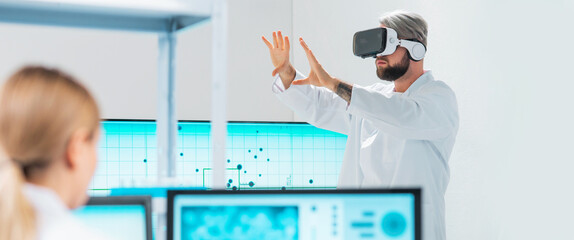In an ever-evolving landscape of technological innovation, Virtual Reality (VR) and Augmented Reality (AR) have emerged as transformative technologies with the potential to reshape how we interact with the digital world. In this article, we’ll delve into what VR and AR entail, their applications, convergence, challenges, future trends, and their collective impact on the future of technology.
1. Introduction to Virtual Reality (VR) and Augmented Reality (AR)
Definition and Overview
Virtual Reality (VR) refers to immersive experiences that simulate physical presence in a digital environment, typically through the use of head-mounted displays (HMDs) and motion-tracking technology. On the other hand, Augmented Reality (AR) overlays digital content onto the real world, enhancing our perception of reality through smartphone apps or specialized AR glasses
Historical Background
The concept of VR dates back to the 1960s, with early experiments in immersive environments and simulated experiences. AR, meanwhile, gained prominence in the late 20th century, with notable advancements such as the introduction of wearable AR devices and smartphone-based AR applications.

2. Understanding Virtual Reality (VR)
Immersive Experiences
VR offers users the opportunity to immerse themselves in simulated environments, whether they’re exploring fantastical worlds, engaging in virtual training exercises, or experiencing interactive storytelling. Head-mounted displays (HMDs) serve as the primary interface for VR experiences, providing a sense of presence and immersion.
Applications of VR
From gaming and entertainment to education and healthcare, VR has diverse applications across various industries. In gaming, VR enables players to step into the shoes of their favorite characters and interact with virtual worlds in unprecedented ways. In healthcare, VR is used for medical training, pain management, and therapeutic interventions.

3. Exploring Augmented Reality (AR)
Overlaying Digital Content
AR seamlessly integrates digital content into the real world, enhancing our perception of reality and providing valuable contextual information. AR experiences can range from simple smartphone apps that overlay virtual objects onto physical surfaces to sophisticated AR glasses that enable hands-free interaction with digital content.
AR Applications
In retail and marketing, AR is revolutionizing the way businesses engage with customers, allowing them to visualize products in their own environment before making a purchase. In education and training, AR enhances learning experiences by providing interactive and immersive simulations that cater to individual learning styles.

4. Convergence of VR and AR
Mixed Reality (MR)
Mixed Reality (MR) represents the convergence of VR and AR technologies, blending physical and digital worlds to create seamless and interactive experiences. Devices like the Microsoft HoloLens enable users to interact with holographic objects overlaid onto their real-world surroundings, opening up new possibilities for collaboration and productivity.
Applications and Use Cases
In healthcare, MR technologies are revolutionizing medical education, surgical planning, and patient care by providing surgeons with immersive simulations and augmented visualization tools. In architecture and design, MR enables architects and engineers to visualize and manipulate digital models in real-time, improving the design process and enhancing collaboration.

5. Challenges and Considerations
Technological Limitations
Despite their potential, VR and AR technologies face challenges such as high hardware costs, limited content availability, and concerns about motion sickness and discomfort. Advancements in hardware design and software optimization are needed to address these limitations and improve the user experience.
Ethical and Social Implications
As VR and AR become more integrated into everyday life, ethical and social considerations arise, including privacy concerns related to data collection and surveillance, as well as the potential for digital addiction and social isolation. It’s essential for developers and policymakers to address these issues and ensure responsible and ethical use of VR and AR technologies.
6. Future Trends and Innovations
Advancements in Hardware
The future of VR and AR is marked by advancements in hardware design and functionality, including the development of wireless VR headsets and lightweight AR glasses that offer improved comfort and mobility. These innovations will make VR and AR more accessible and convenient for users, driving greater adoption and market growth.
Expanding Market Opportunities
As VR and AR technologies mature, new market opportunities are emerging, particularly in enterprise applications such as virtual meetings, remote collaboration, and virtual training. At the same time, consumer adoption of VR and AR is expected to increase, fueled by advancements in content creation, immersive storytelling, and social experiences.
Conclusion
In conclusion, Virtual Reality (VR) and Augmented Reality (AR) are poised to revolutionize the way we interact with digital content and experience the world around us. From immersive gaming and educational simulations to practical applications in healthcare and industry, VR and AR offer limitless possibilities for innovation and creativity. As these technologies continue to evolve and converge, they will play an increasingly integral role in shaping the future of technology and human experience.

FAQs (Frequently Asked Questions)
- What are some examples of VR applications? Examples of VR applications include virtual gaming experiences, immersive simulations for training and education, virtual tours of real-world locations, and therapeutic interventions for mental health
- How does AR enhance retail experiences? AR enhances retail experiences by allowing customers to visualize products in their own environment before making a purchase. Retailers can use AR apps to overlay virtual furniture, clothing, or cosmetics onto the customer’s surroundings, enabling them to see how the products will look and fit in real life.
- What are some challenges of VR and AR technology? Challenges of VR and AR technology include high hardware costs, limited content availability, concerns about motion sickness and discomfort, privacy issues related to data collection, and ethical considerations regarding digital addiction and social isolation.
- How are VR and AR being used in healthcare? VR and AR are being used in healthcare for medical training, surgical planning, patient rehabilitation, pain management, and therapeutic interventions. These technologies enable healthcare professionals to visualize complex medical data, simulate surgical procedures, and provide immersive experiences for patients.
- What are some future trends in VR and AR development? Future trends in VR and AR development include advancements in hardware design, such as wireless VR headsets and lightweight AR glasses, as well as expanding market opportunities in enterprise applications, consumer adoption, and immersive content creation.





